Analysis of Community Mental Health and Inpatient Hospital Services
VerifiedAdded on 2023/06/14
|12
|3036
|198
Essay
AI Summary
This essay explores the effectiveness of community mental health services versus inpatient hospital services in providing care for individuals with mental health issues and learning disabilities. It examines the needs of this vulnerable group, including communication, health, and medication requirements, while also considering the importance of cultural sensitivity and ethical practices. The essay evaluates the role of psychiatric wards, community centers, and support services, highlighting the benefits of community-based care in maintaining family relationships and promoting independence. It also addresses the challenges associated with inpatient services, such as potential stigmatization and limitations on personal freedom. Furthermore, the essay emphasizes the need for accurate diagnosis, confidentiality, and a collaborative approach involving healthcare professionals, families, and community support teams to ensure comprehensive and effective care for individuals with mental health problems and disabilities.
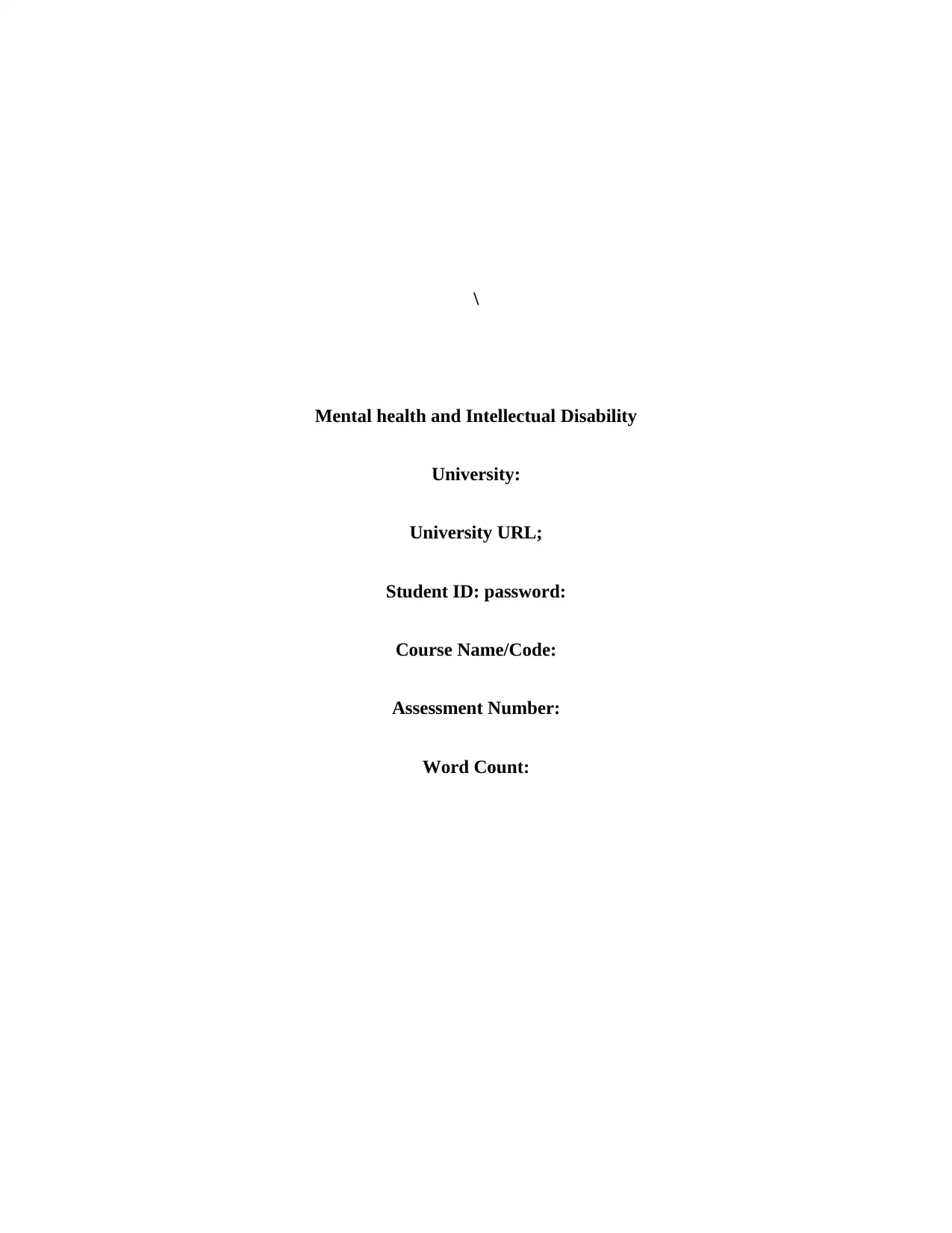
\
Mental health and Intellectual Disability
University:
University URL;
Student ID: password:
Course Name/Code:
Assessment Number:
Word Count:
Mental health and Intellectual Disability
University:
University URL;
Student ID: password:
Course Name/Code:
Assessment Number:
Word Count:
Paraphrase This Document
Need a fresh take? Get an instant paraphrase of this document with our AI Paraphraser
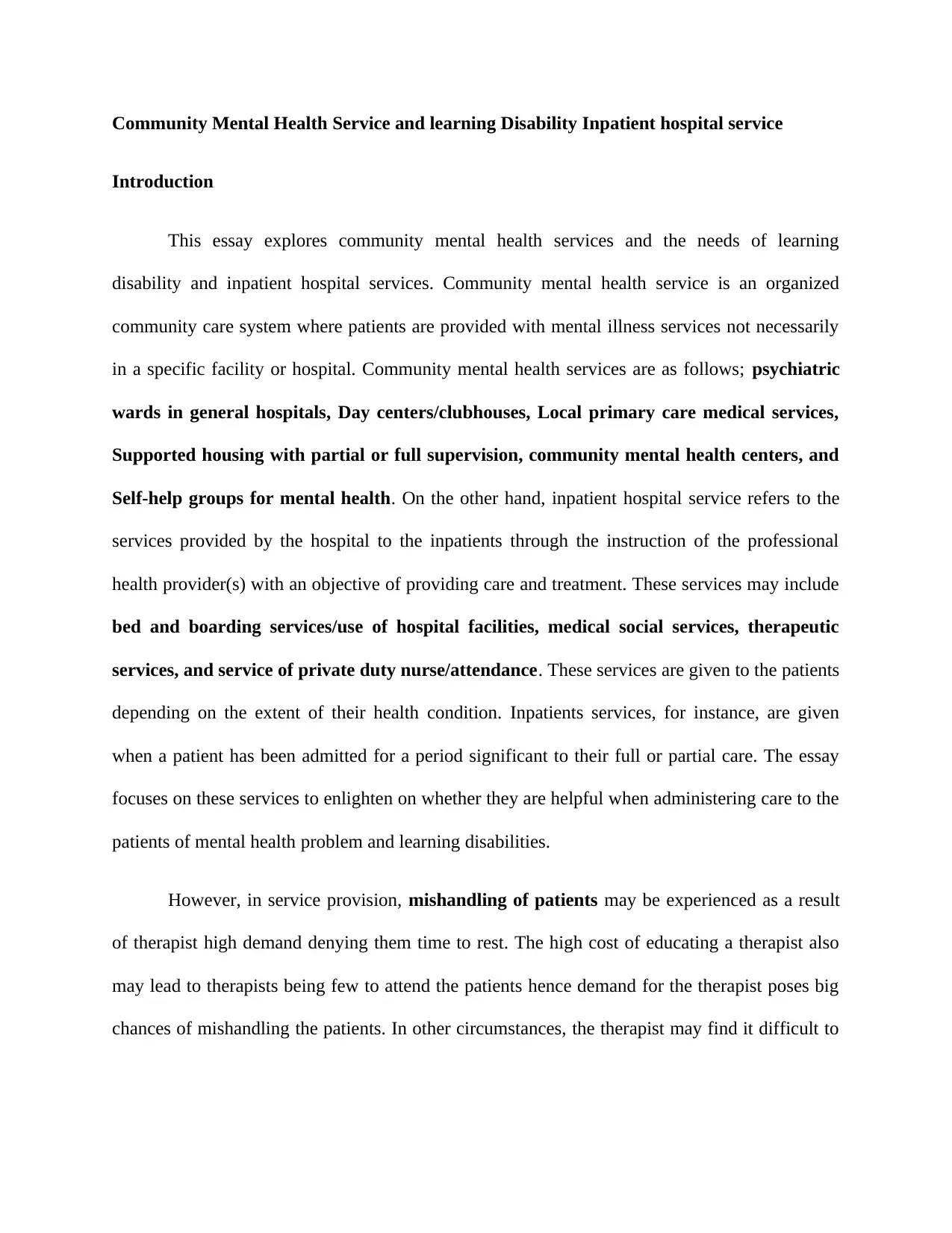
Community Mental Health Service and learning Disability Inpatient hospital service
Introduction
This essay explores community mental health services and the needs of learning
disability and inpatient hospital services. Community mental health service is an organized
community care system where patients are provided with mental illness services not necessarily
in a specific facility or hospital. Community mental health services are as follows; psychiatric
wards in general hospitals, Day centers/clubhouses, Local primary care medical services,
Supported housing with partial or full supervision, community mental health centers, and
Self-help groups for mental health. On the other hand, inpatient hospital service refers to the
services provided by the hospital to the inpatients through the instruction of the professional
health provider(s) with an objective of providing care and treatment. These services may include
bed and boarding services/use of hospital facilities, medical social services, therapeutic
services, and service of private duty nurse/attendance. These services are given to the patients
depending on the extent of their health condition. Inpatients services, for instance, are given
when a patient has been admitted for a period significant to their full or partial care. The essay
focuses on these services to enlighten on whether they are helpful when administering care to the
patients of mental health problem and learning disabilities.
However, in service provision, mishandling of patients may be experienced as a result
of therapist high demand denying them time to rest. The high cost of educating a therapist also
may lead to therapists being few to attend the patients hence demand for the therapist poses big
chances of mishandling the patients. In other circumstances, the therapist may find it difficult to
Introduction
This essay explores community mental health services and the needs of learning
disability and inpatient hospital services. Community mental health service is an organized
community care system where patients are provided with mental illness services not necessarily
in a specific facility or hospital. Community mental health services are as follows; psychiatric
wards in general hospitals, Day centers/clubhouses, Local primary care medical services,
Supported housing with partial or full supervision, community mental health centers, and
Self-help groups for mental health. On the other hand, inpatient hospital service refers to the
services provided by the hospital to the inpatients through the instruction of the professional
health provider(s) with an objective of providing care and treatment. These services may include
bed and boarding services/use of hospital facilities, medical social services, therapeutic
services, and service of private duty nurse/attendance. These services are given to the patients
depending on the extent of their health condition. Inpatients services, for instance, are given
when a patient has been admitted for a period significant to their full or partial care. The essay
focuses on these services to enlighten on whether they are helpful when administering care to the
patients of mental health problem and learning disabilities.
However, in service provision, mishandling of patients may be experienced as a result
of therapist high demand denying them time to rest. The high cost of educating a therapist also
may lead to therapists being few to attend the patients hence demand for the therapist poses big
chances of mishandling the patients. In other circumstances, the therapist may find it difficult to
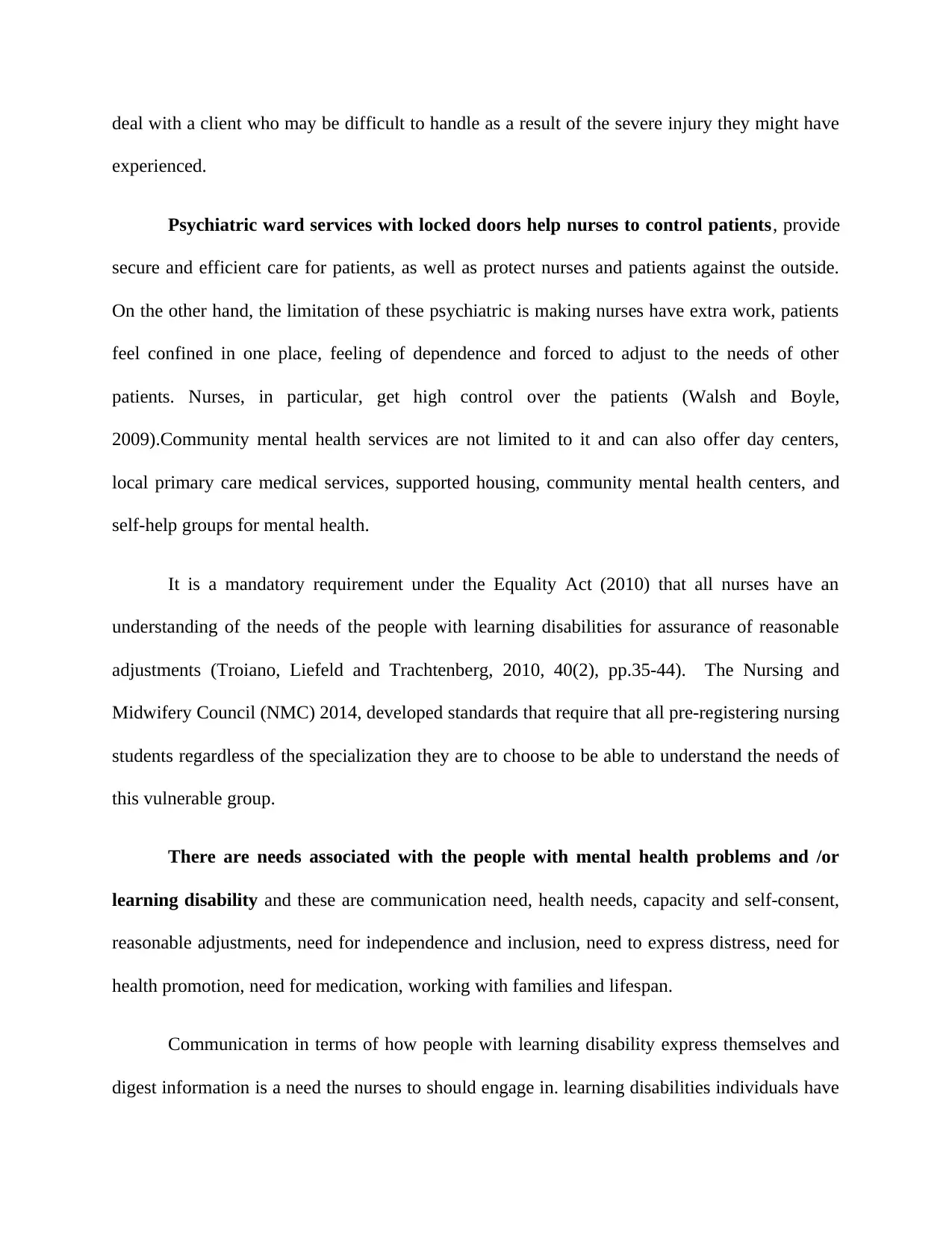
deal with a client who may be difficult to handle as a result of the severe injury they might have
experienced.
Psychiatric ward services with locked doors help nurses to control patients, provide
secure and efficient care for patients, as well as protect nurses and patients against the outside.
On the other hand, the limitation of these psychiatric is making nurses have extra work, patients
feel confined in one place, feeling of dependence and forced to adjust to the needs of other
patients. Nurses, in particular, get high control over the patients (Walsh and Boyle,
2009).Community mental health services are not limited to it and can also offer day centers,
local primary care medical services, supported housing, community mental health centers, and
self-help groups for mental health.
It is a mandatory requirement under the Equality Act (2010) that all nurses have an
understanding of the needs of the people with learning disabilities for assurance of reasonable
adjustments (Troiano, Liefeld and Trachtenberg, 2010, 40(2), pp.35-44). The Nursing and
Midwifery Council (NMC) 2014, developed standards that require that all pre-registering nursing
students regardless of the specialization they are to choose to be able to understand the needs of
this vulnerable group.
There are needs associated with the people with mental health problems and /or
learning disability and these are communication need, health needs, capacity and self-consent,
reasonable adjustments, need for independence and inclusion, need to express distress, need for
health promotion, need for medication, working with families and lifespan.
Communication in terms of how people with learning disability express themselves and
digest information is a need the nurses to should engage in. learning disabilities individuals have
experienced.
Psychiatric ward services with locked doors help nurses to control patients, provide
secure and efficient care for patients, as well as protect nurses and patients against the outside.
On the other hand, the limitation of these psychiatric is making nurses have extra work, patients
feel confined in one place, feeling of dependence and forced to adjust to the needs of other
patients. Nurses, in particular, get high control over the patients (Walsh and Boyle,
2009).Community mental health services are not limited to it and can also offer day centers,
local primary care medical services, supported housing, community mental health centers, and
self-help groups for mental health.
It is a mandatory requirement under the Equality Act (2010) that all nurses have an
understanding of the needs of the people with learning disabilities for assurance of reasonable
adjustments (Troiano, Liefeld and Trachtenberg, 2010, 40(2), pp.35-44). The Nursing and
Midwifery Council (NMC) 2014, developed standards that require that all pre-registering nursing
students regardless of the specialization they are to choose to be able to understand the needs of
this vulnerable group.
There are needs associated with the people with mental health problems and /or
learning disability and these are communication need, health needs, capacity and self-consent,
reasonable adjustments, need for independence and inclusion, need to express distress, need for
health promotion, need for medication, working with families and lifespan.
Communication in terms of how people with learning disability express themselves and
digest information is a need the nurses to should engage in. learning disabilities individuals have
⊘ This is a preview!⊘
Do you want full access?
Subscribe today to unlock all pages.

Trusted by 1+ million students worldwide
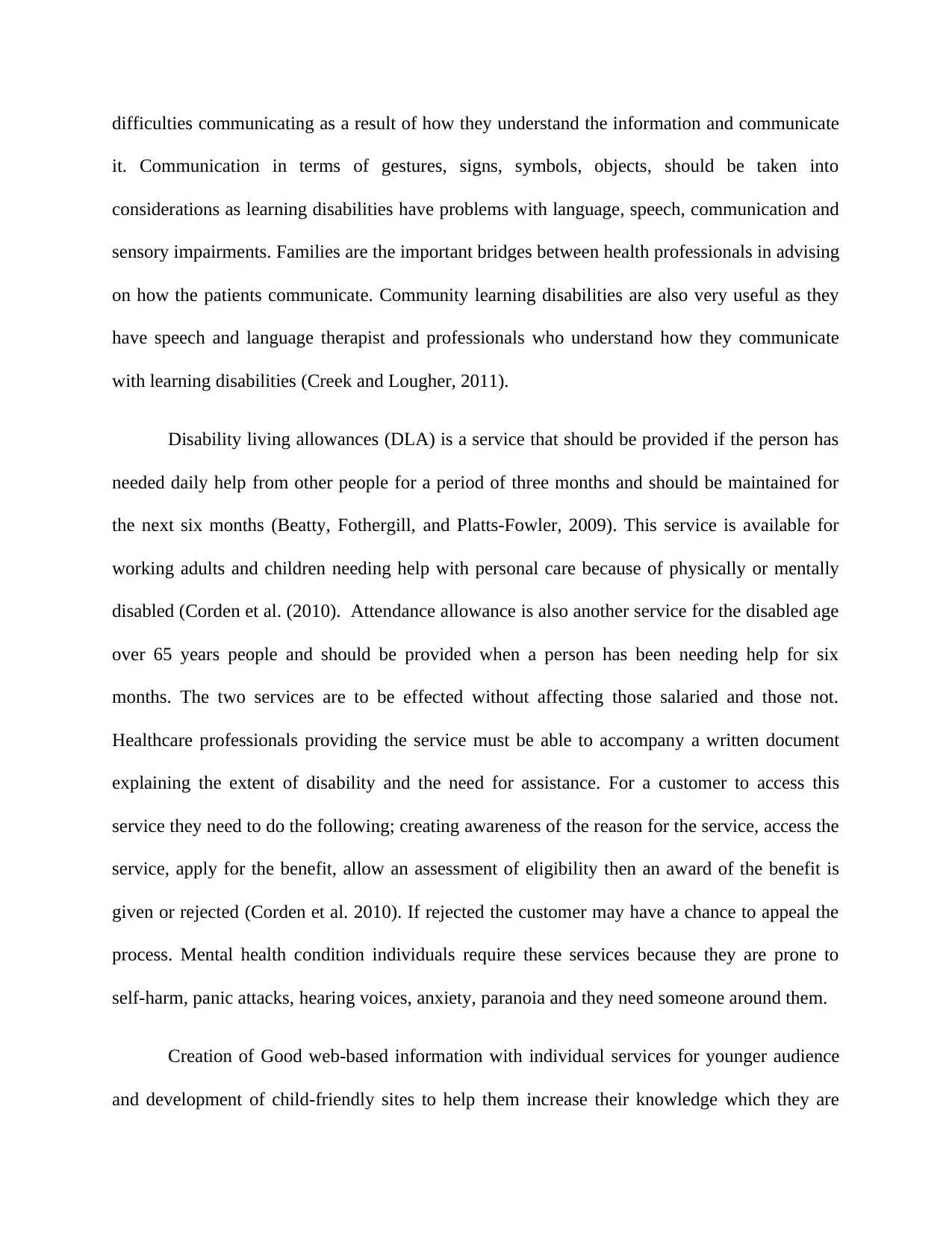
difficulties communicating as a result of how they understand the information and communicate
it. Communication in terms of gestures, signs, symbols, objects, should be taken into
considerations as learning disabilities have problems with language, speech, communication and
sensory impairments. Families are the important bridges between health professionals in advising
on how the patients communicate. Community learning disabilities are also very useful as they
have speech and language therapist and professionals who understand how they communicate
with learning disabilities (Creek and Lougher, 2011).
Disability living allowances (DLA) is a service that should be provided if the person has
needed daily help from other people for a period of three months and should be maintained for
the next six months (Beatty, Fothergill, and Platts-Fowler, 2009). This service is available for
working adults and children needing help with personal care because of physically or mentally
disabled (Corden et al. (2010). Attendance allowance is also another service for the disabled age
over 65 years people and should be provided when a person has been needing help for six
months. The two services are to be effected without affecting those salaried and those not.
Healthcare professionals providing the service must be able to accompany a written document
explaining the extent of disability and the need for assistance. For a customer to access this
service they need to do the following; creating awareness of the reason for the service, access the
service, apply for the benefit, allow an assessment of eligibility then an award of the benefit is
given or rejected (Corden et al. 2010). If rejected the customer may have a chance to appeal the
process. Mental health condition individuals require these services because they are prone to
self-harm, panic attacks, hearing voices, anxiety, paranoia and they need someone around them.
Creation of Good web-based information with individual services for younger audience
and development of child-friendly sites to help them increase their knowledge which they are
it. Communication in terms of gestures, signs, symbols, objects, should be taken into
considerations as learning disabilities have problems with language, speech, communication and
sensory impairments. Families are the important bridges between health professionals in advising
on how the patients communicate. Community learning disabilities are also very useful as they
have speech and language therapist and professionals who understand how they communicate
with learning disabilities (Creek and Lougher, 2011).
Disability living allowances (DLA) is a service that should be provided if the person has
needed daily help from other people for a period of three months and should be maintained for
the next six months (Beatty, Fothergill, and Platts-Fowler, 2009). This service is available for
working adults and children needing help with personal care because of physically or mentally
disabled (Corden et al. (2010). Attendance allowance is also another service for the disabled age
over 65 years people and should be provided when a person has been needing help for six
months. The two services are to be effected without affecting those salaried and those not.
Healthcare professionals providing the service must be able to accompany a written document
explaining the extent of disability and the need for assistance. For a customer to access this
service they need to do the following; creating awareness of the reason for the service, access the
service, apply for the benefit, allow an assessment of eligibility then an award of the benefit is
given or rejected (Corden et al. 2010). If rejected the customer may have a chance to appeal the
process. Mental health condition individuals require these services because they are prone to
self-harm, panic attacks, hearing voices, anxiety, paranoia and they need someone around them.
Creation of Good web-based information with individual services for younger audience
and development of child-friendly sites to help them increase their knowledge which they are
Paraphrase This Document
Need a fresh take? Get an instant paraphrase of this document with our AI Paraphraser

unlikely to hear from the adult such as their parents and cares is advisable (Schieve et al. 2012
pp.467-476). So the communication in these websites should be reflective of their needs and
services of the transition from childhood to adulthood (Burns et al. 2010, p.S22).
Health needs. People with disability prematurely die before their counterparts’
population. People dying from multiple disabilities die of deaths that could have been avoided
with quality healthcare. Certain cancers, CHD, and respiratory diseases are the main cause of
these deaths (Heslop et al. 2014, 383(9920), pp.889-895). Nurses will be accountable for the
provision of compassion, and effective care and treatment to people with these special needs
(Thomas et al. 2010, 67(6), pp.614-623).
There is a need for adjustments to enable people with disability to access healthcare.
These would include even physical adjustments, and adaptation adjustments to help persons with
learning disabilities to understand and engage in their health care (Edwards and Elwyn, 2009).
Nurses should be aware of the laws covering this area, reflect on their own attitude beliefs and
practices of working with the people with learning disabilities as well as identify areas where
such user-friendly and resources can be found. Nurses also need to collaborate with the
community learning disability teams to work as a unit in improving health in hospitals.
Need for medication. Learning disabilities are likely to be diagnosed with several
medications due to the likelihood of developing other complications. They need additional
medication to deal with this other complication they develop compared to non-learning
disabilities. However, precaution must be taken to avoid overmedication to people with learning
disabilities.
pp.467-476). So the communication in these websites should be reflective of their needs and
services of the transition from childhood to adulthood (Burns et al. 2010, p.S22).
Health needs. People with disability prematurely die before their counterparts’
population. People dying from multiple disabilities die of deaths that could have been avoided
with quality healthcare. Certain cancers, CHD, and respiratory diseases are the main cause of
these deaths (Heslop et al. 2014, 383(9920), pp.889-895). Nurses will be accountable for the
provision of compassion, and effective care and treatment to people with these special needs
(Thomas et al. 2010, 67(6), pp.614-623).
There is a need for adjustments to enable people with disability to access healthcare.
These would include even physical adjustments, and adaptation adjustments to help persons with
learning disabilities to understand and engage in their health care (Edwards and Elwyn, 2009).
Nurses should be aware of the laws covering this area, reflect on their own attitude beliefs and
practices of working with the people with learning disabilities as well as identify areas where
such user-friendly and resources can be found. Nurses also need to collaborate with the
community learning disability teams to work as a unit in improving health in hospitals.
Need for medication. Learning disabilities are likely to be diagnosed with several
medications due to the likelihood of developing other complications. They need additional
medication to deal with this other complication they develop compared to non-learning
disabilities. However, precaution must be taken to avoid overmedication to people with learning
disabilities.
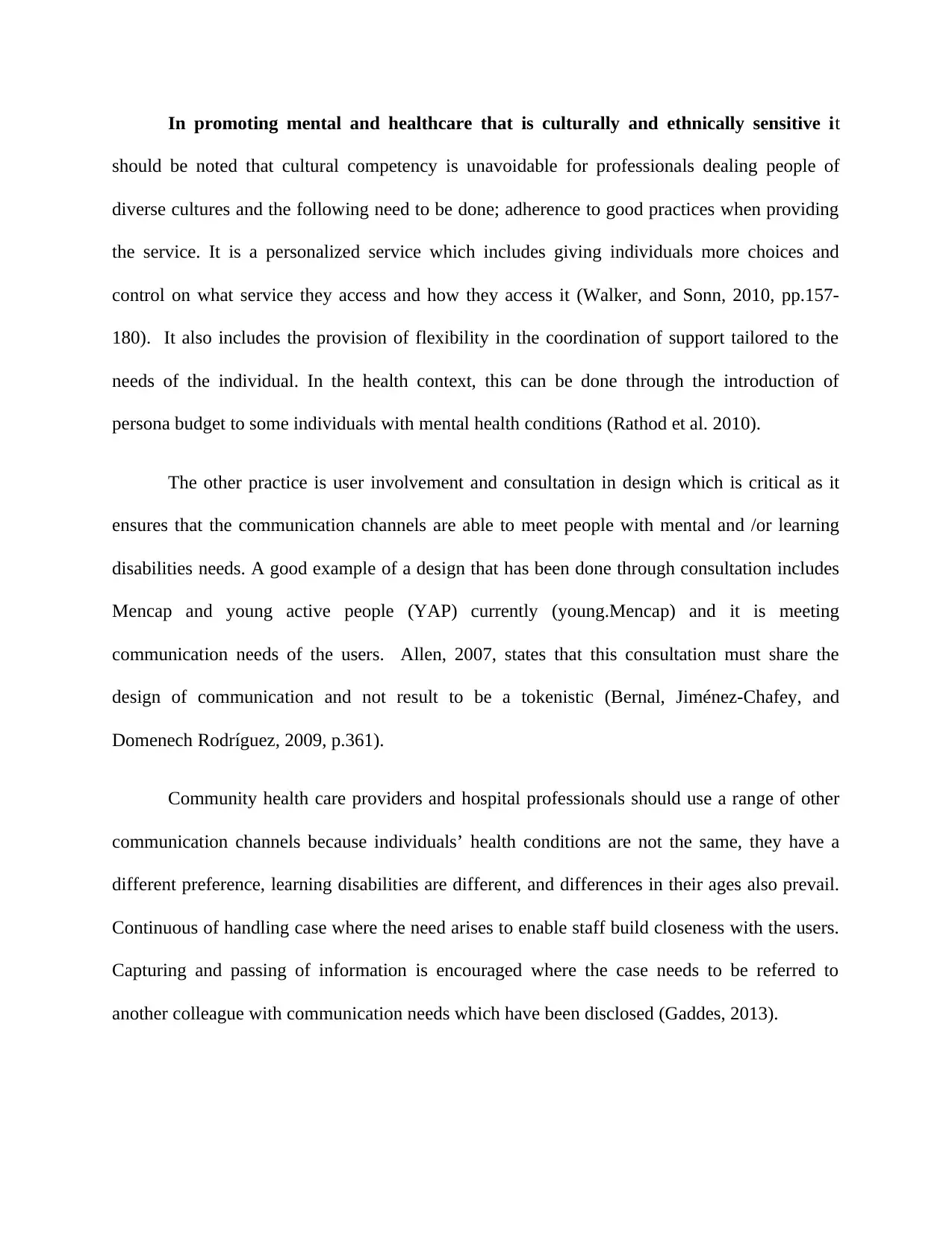
In promoting mental and healthcare that is culturally and ethnically sensitive it
should be noted that cultural competency is unavoidable for professionals dealing people of
diverse cultures and the following need to be done; adherence to good practices when providing
the service. It is a personalized service which includes giving individuals more choices and
control on what service they access and how they access it (Walker, and Sonn, 2010, pp.157-
180). It also includes the provision of flexibility in the coordination of support tailored to the
needs of the individual. In the health context, this can be done through the introduction of
persona budget to some individuals with mental health conditions (Rathod et al. 2010).
The other practice is user involvement and consultation in design which is critical as it
ensures that the communication channels are able to meet people with mental and /or learning
disabilities needs. A good example of a design that has been done through consultation includes
Mencap and young active people (YAP) currently (young.Mencap) and it is meeting
communication needs of the users. Allen, 2007, states that this consultation must share the
design of communication and not result to be a tokenistic (Bernal, Jiménez-Chafey, and
Domenech Rodríguez, 2009, p.361).
Community health care providers and hospital professionals should use a range of other
communication channels because individuals’ health conditions are not the same, they have a
different preference, learning disabilities are different, and differences in their ages also prevail.
Continuous of handling case where the need arises to enable staff build closeness with the users.
Capturing and passing of information is encouraged where the case needs to be referred to
another colleague with communication needs which have been disclosed (Gaddes, 2013).
should be noted that cultural competency is unavoidable for professionals dealing people of
diverse cultures and the following need to be done; adherence to good practices when providing
the service. It is a personalized service which includes giving individuals more choices and
control on what service they access and how they access it (Walker, and Sonn, 2010, pp.157-
180). It also includes the provision of flexibility in the coordination of support tailored to the
needs of the individual. In the health context, this can be done through the introduction of
persona budget to some individuals with mental health conditions (Rathod et al. 2010).
The other practice is user involvement and consultation in design which is critical as it
ensures that the communication channels are able to meet people with mental and /or learning
disabilities needs. A good example of a design that has been done through consultation includes
Mencap and young active people (YAP) currently (young.Mencap) and it is meeting
communication needs of the users. Allen, 2007, states that this consultation must share the
design of communication and not result to be a tokenistic (Bernal, Jiménez-Chafey, and
Domenech Rodríguez, 2009, p.361).
Community health care providers and hospital professionals should use a range of other
communication channels because individuals’ health conditions are not the same, they have a
different preference, learning disabilities are different, and differences in their ages also prevail.
Continuous of handling case where the need arises to enable staff build closeness with the users.
Capturing and passing of information is encouraged where the case needs to be referred to
another colleague with communication needs which have been disclosed (Gaddes, 2013).
⊘ This is a preview!⊘
Do you want full access?
Subscribe today to unlock all pages.

Trusted by 1+ million students worldwide
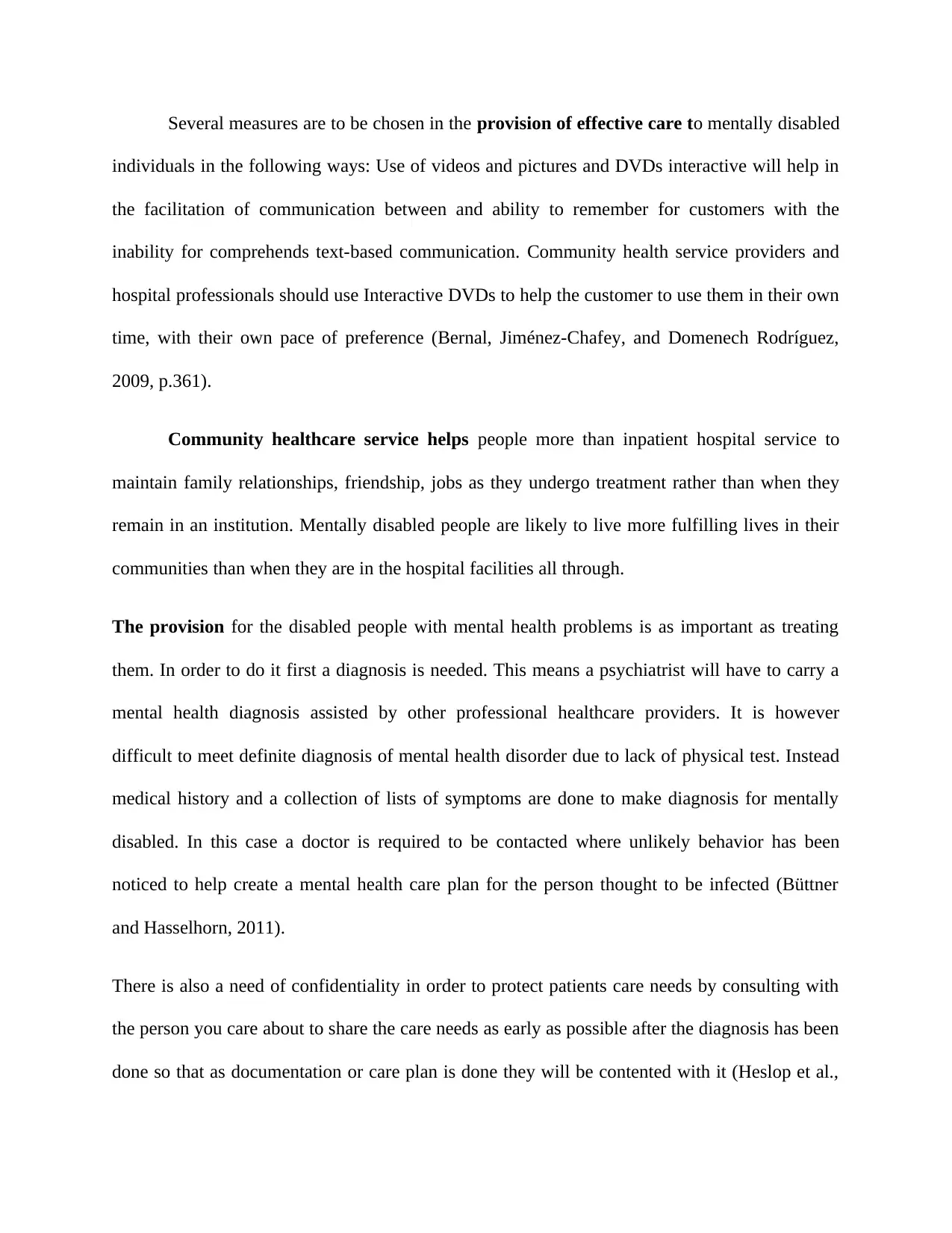
Several measures are to be chosen in the provision of effective care to mentally disabled
individuals in the following ways: Use of videos and pictures and DVDs interactive will help in
the facilitation of communication between and ability to remember for customers with the
inability for comprehends text-based communication. Community health service providers and
hospital professionals should use Interactive DVDs to help the customer to use them in their own
time, with their own pace of preference (Bernal, Jiménez-Chafey, and Domenech Rodríguez,
2009, p.361).
Community healthcare service helps people more than inpatient hospital service to
maintain family relationships, friendship, jobs as they undergo treatment rather than when they
remain in an institution. Mentally disabled people are likely to live more fulfilling lives in their
communities than when they are in the hospital facilities all through.
The provision for the disabled people with mental health problems is as important as treating
them. In order to do it first a diagnosis is needed. This means a psychiatrist will have to carry a
mental health diagnosis assisted by other professional healthcare providers. It is however
difficult to meet definite diagnosis of mental health disorder due to lack of physical test. Instead
medical history and a collection of lists of symptoms are done to make diagnosis for mentally
disabled. In this case a doctor is required to be contacted where unlikely behavior has been
noticed to help create a mental health care plan for the person thought to be infected (Büttner
and Hasselhorn, 2011).
There is also a need of confidentiality in order to protect patients care needs by consulting with
the person you care about to share the care needs as early as possible after the diagnosis has been
done so that as documentation or care plan is done they will be contented with it (Heslop et al.,
individuals in the following ways: Use of videos and pictures and DVDs interactive will help in
the facilitation of communication between and ability to remember for customers with the
inability for comprehends text-based communication. Community health service providers and
hospital professionals should use Interactive DVDs to help the customer to use them in their own
time, with their own pace of preference (Bernal, Jiménez-Chafey, and Domenech Rodríguez,
2009, p.361).
Community healthcare service helps people more than inpatient hospital service to
maintain family relationships, friendship, jobs as they undergo treatment rather than when they
remain in an institution. Mentally disabled people are likely to live more fulfilling lives in their
communities than when they are in the hospital facilities all through.
The provision for the disabled people with mental health problems is as important as treating
them. In order to do it first a diagnosis is needed. This means a psychiatrist will have to carry a
mental health diagnosis assisted by other professional healthcare providers. It is however
difficult to meet definite diagnosis of mental health disorder due to lack of physical test. Instead
medical history and a collection of lists of symptoms are done to make diagnosis for mentally
disabled. In this case a doctor is required to be contacted where unlikely behavior has been
noticed to help create a mental health care plan for the person thought to be infected (Büttner
and Hasselhorn, 2011).
There is also a need of confidentiality in order to protect patients care needs by consulting with
the person you care about to share the care needs as early as possible after the diagnosis has been
done so that as documentation or care plan is done they will be contented with it (Heslop et al.,
Paraphrase This Document
Need a fresh take? Get an instant paraphrase of this document with our AI Paraphraser
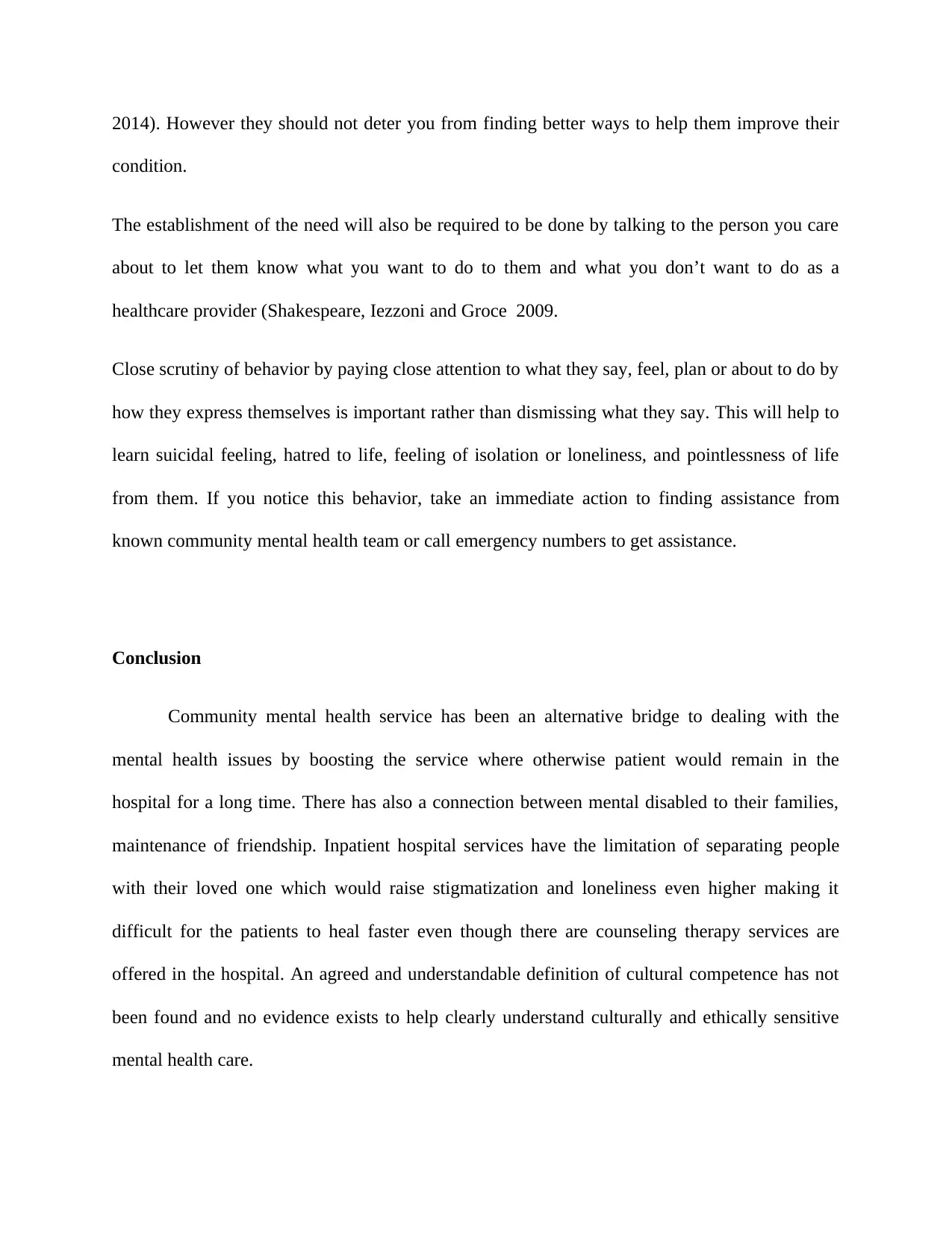
2014). However they should not deter you from finding better ways to help them improve their
condition.
The establishment of the need will also be required to be done by talking to the person you care
about to let them know what you want to do to them and what you don’t want to do as a
healthcare provider (Shakespeare, Iezzoni and Groce 2009.
Close scrutiny of behavior by paying close attention to what they say, feel, plan or about to do by
how they express themselves is important rather than dismissing what they say. This will help to
learn suicidal feeling, hatred to life, feeling of isolation or loneliness, and pointlessness of life
from them. If you notice this behavior, take an immediate action to finding assistance from
known community mental health team or call emergency numbers to get assistance.
Conclusion
Community mental health service has been an alternative bridge to dealing with the
mental health issues by boosting the service where otherwise patient would remain in the
hospital for a long time. There has also a connection between mental disabled to their families,
maintenance of friendship. Inpatient hospital services have the limitation of separating people
with their loved one which would raise stigmatization and loneliness even higher making it
difficult for the patients to heal faster even though there are counseling therapy services are
offered in the hospital. An agreed and understandable definition of cultural competence has not
been found and no evidence exists to help clearly understand culturally and ethically sensitive
mental health care.
condition.
The establishment of the need will also be required to be done by talking to the person you care
about to let them know what you want to do to them and what you don’t want to do as a
healthcare provider (Shakespeare, Iezzoni and Groce 2009.
Close scrutiny of behavior by paying close attention to what they say, feel, plan or about to do by
how they express themselves is important rather than dismissing what they say. This will help to
learn suicidal feeling, hatred to life, feeling of isolation or loneliness, and pointlessness of life
from them. If you notice this behavior, take an immediate action to finding assistance from
known community mental health team or call emergency numbers to get assistance.
Conclusion
Community mental health service has been an alternative bridge to dealing with the
mental health issues by boosting the service where otherwise patient would remain in the
hospital for a long time. There has also a connection between mental disabled to their families,
maintenance of friendship. Inpatient hospital services have the limitation of separating people
with their loved one which would raise stigmatization and loneliness even higher making it
difficult for the patients to heal faster even though there are counseling therapy services are
offered in the hospital. An agreed and understandable definition of cultural competence has not
been found and no evidence exists to help clearly understand culturally and ethically sensitive
mental health care.
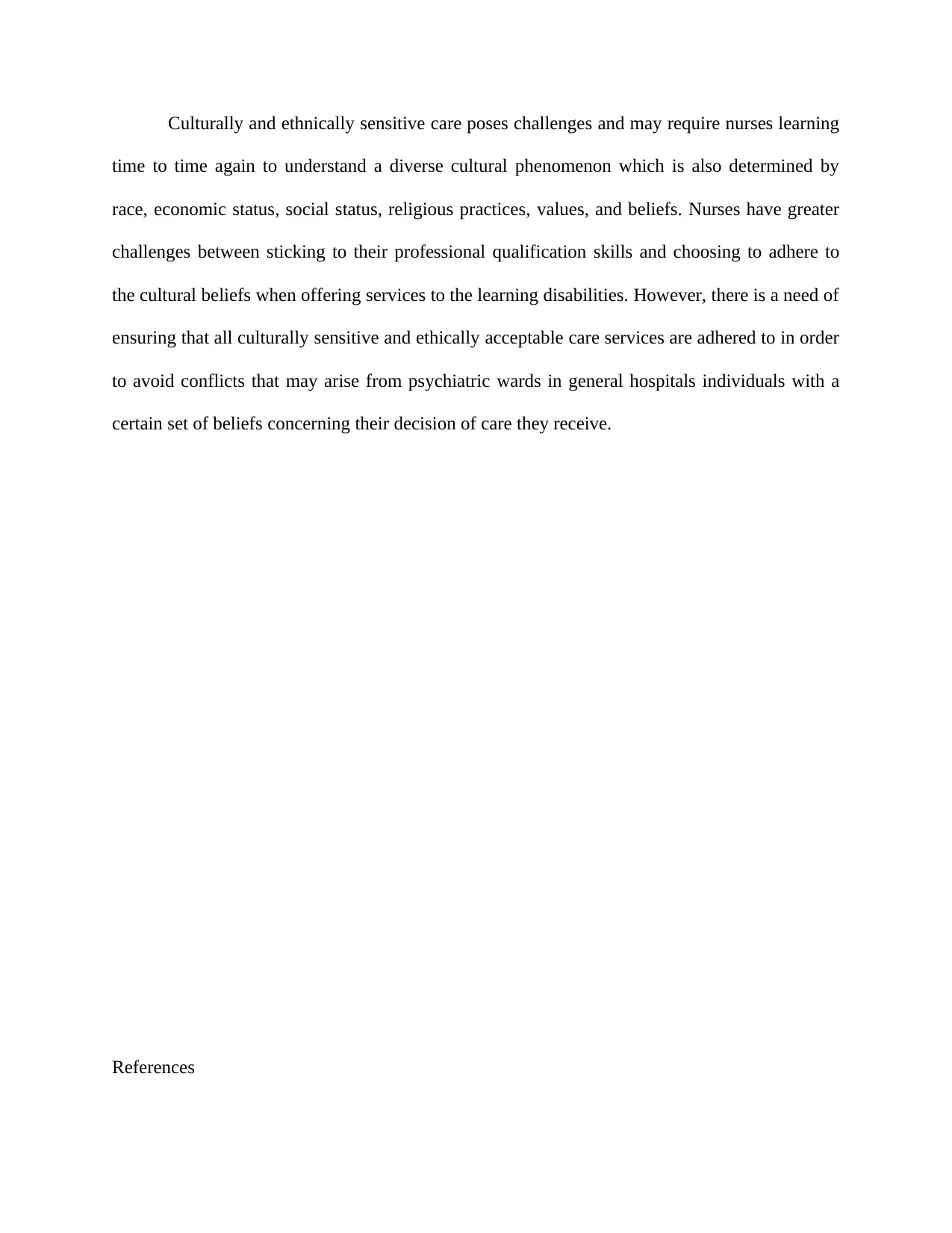
Culturally and ethnically sensitive care poses challenges and may require nurses learning
time to time again to understand a diverse cultural phenomenon which is also determined by
race, economic status, social status, religious practices, values, and beliefs. Nurses have greater
challenges between sticking to their professional qualification skills and choosing to adhere to
the cultural beliefs when offering services to the learning disabilities. However, there is a need of
ensuring that all culturally sensitive and ethically acceptable care services are adhered to in order
to avoid conflicts that may arise from psychiatric wards in general hospitals individuals with a
certain set of beliefs concerning their decision of care they receive.
References
time to time again to understand a diverse cultural phenomenon which is also determined by
race, economic status, social status, religious practices, values, and beliefs. Nurses have greater
challenges between sticking to their professional qualification skills and choosing to adhere to
the cultural beliefs when offering services to the learning disabilities. However, there is a need of
ensuring that all culturally sensitive and ethically acceptable care services are adhered to in order
to avoid conflicts that may arise from psychiatric wards in general hospitals individuals with a
certain set of beliefs concerning their decision of care they receive.
References
⊘ This is a preview!⊘
Do you want full access?
Subscribe today to unlock all pages.

Trusted by 1+ million students worldwide
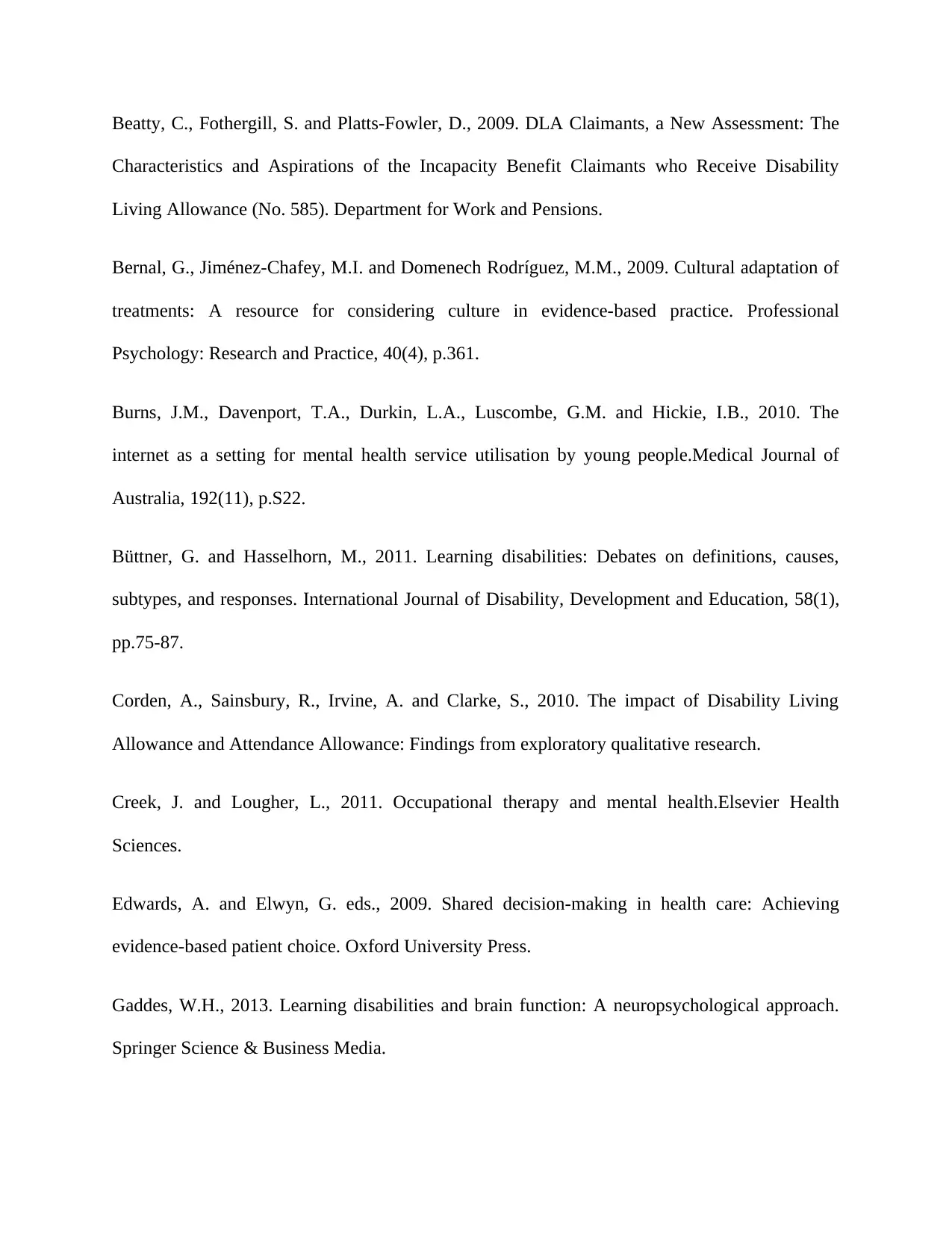
Beatty, C., Fothergill, S. and Platts-Fowler, D., 2009. DLA Claimants, a New Assessment: The
Characteristics and Aspirations of the Incapacity Benefit Claimants who Receive Disability
Living Allowance (No. 585). Department for Work and Pensions.
Bernal, G., Jiménez-Chafey, M.I. and Domenech Rodríguez, M.M., 2009. Cultural adaptation of
treatments: A resource for considering culture in evidence-based practice. Professional
Psychology: Research and Practice, 40(4), p.361.
Burns, J.M., Davenport, T.A., Durkin, L.A., Luscombe, G.M. and Hickie, I.B., 2010. The
internet as a setting for mental health service utilisation by young people.Medical Journal of
Australia, 192(11), p.S22.
Büttner, G. and Hasselhorn, M., 2011. Learning disabilities: Debates on definitions, causes,
subtypes, and responses. International Journal of Disability, Development and Education, 58(1),
pp.75-87.
Corden, A., Sainsbury, R., Irvine, A. and Clarke, S., 2010. The impact of Disability Living
Allowance and Attendance Allowance: Findings from exploratory qualitative research.
Creek, J. and Lougher, L., 2011. Occupational therapy and mental health.Elsevier Health
Sciences.
Edwards, A. and Elwyn, G. eds., 2009. Shared decision-making in health care: Achieving
evidence-based patient choice. Oxford University Press.
Gaddes, W.H., 2013. Learning disabilities and brain function: A neuropsychological approach.
Springer Science & Business Media.
Characteristics and Aspirations of the Incapacity Benefit Claimants who Receive Disability
Living Allowance (No. 585). Department for Work and Pensions.
Bernal, G., Jiménez-Chafey, M.I. and Domenech Rodríguez, M.M., 2009. Cultural adaptation of
treatments: A resource for considering culture in evidence-based practice. Professional
Psychology: Research and Practice, 40(4), p.361.
Burns, J.M., Davenport, T.A., Durkin, L.A., Luscombe, G.M. and Hickie, I.B., 2010. The
internet as a setting for mental health service utilisation by young people.Medical Journal of
Australia, 192(11), p.S22.
Büttner, G. and Hasselhorn, M., 2011. Learning disabilities: Debates on definitions, causes,
subtypes, and responses. International Journal of Disability, Development and Education, 58(1),
pp.75-87.
Corden, A., Sainsbury, R., Irvine, A. and Clarke, S., 2010. The impact of Disability Living
Allowance and Attendance Allowance: Findings from exploratory qualitative research.
Creek, J. and Lougher, L., 2011. Occupational therapy and mental health.Elsevier Health
Sciences.
Edwards, A. and Elwyn, G. eds., 2009. Shared decision-making in health care: Achieving
evidence-based patient choice. Oxford University Press.
Gaddes, W.H., 2013. Learning disabilities and brain function: A neuropsychological approach.
Springer Science & Business Media.
Paraphrase This Document
Need a fresh take? Get an instant paraphrase of this document with our AI Paraphraser
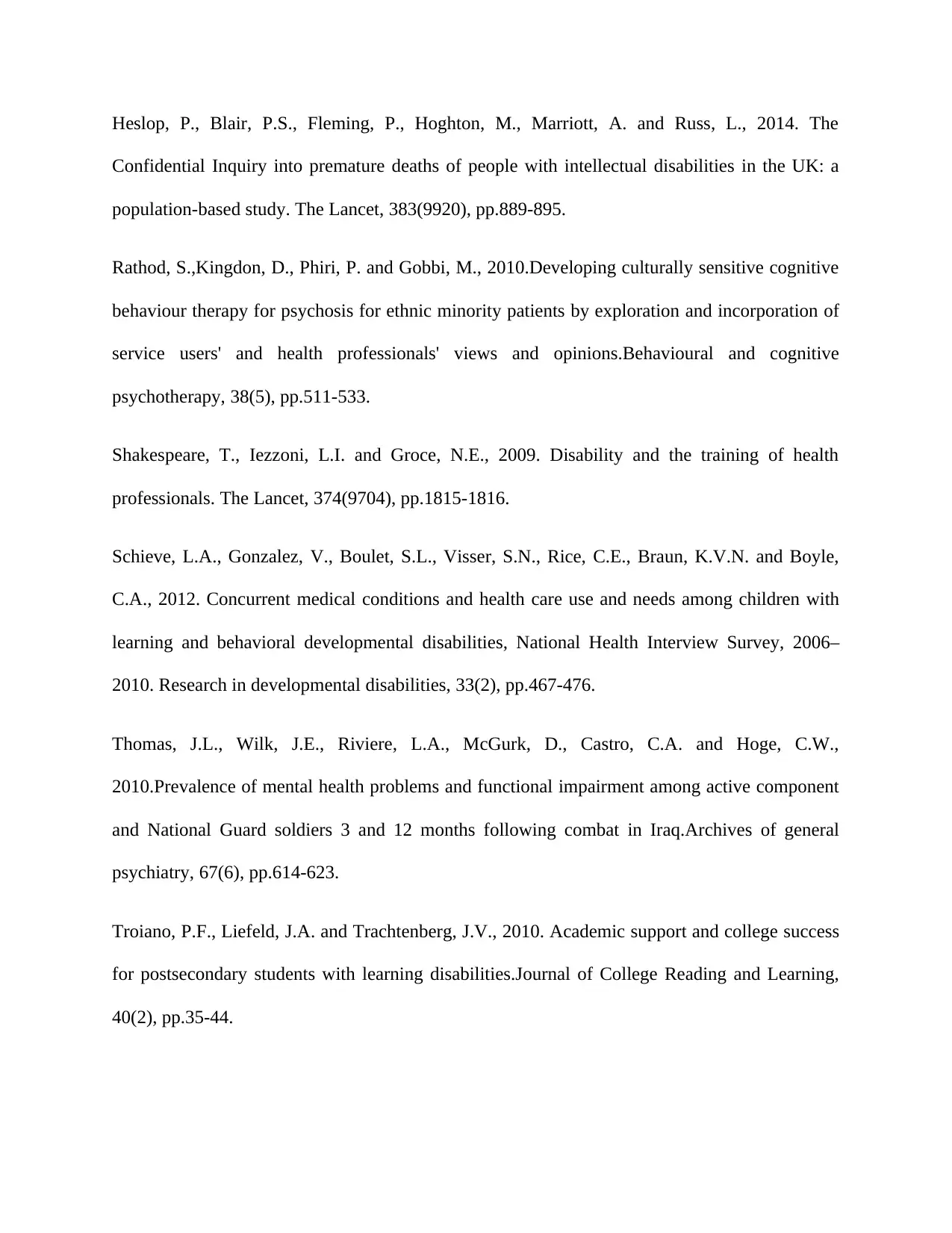
Heslop, P., Blair, P.S., Fleming, P., Hoghton, M., Marriott, A. and Russ, L., 2014. The
Confidential Inquiry into premature deaths of people with intellectual disabilities in the UK: a
population-based study. The Lancet, 383(9920), pp.889-895.
Rathod, S.,Kingdon, D., Phiri, P. and Gobbi, M., 2010.Developing culturally sensitive cognitive
behaviour therapy for psychosis for ethnic minority patients by exploration and incorporation of
service users' and health professionals' views and opinions.Behavioural and cognitive
psychotherapy, 38(5), pp.511-533.
Shakespeare, T., Iezzoni, L.I. and Groce, N.E., 2009. Disability and the training of health
professionals. The Lancet, 374(9704), pp.1815-1816.
Schieve, L.A., Gonzalez, V., Boulet, S.L., Visser, S.N., Rice, C.E., Braun, K.V.N. and Boyle,
C.A., 2012. Concurrent medical conditions and health care use and needs among children with
learning and behavioral developmental disabilities, National Health Interview Survey, 2006–
2010. Research in developmental disabilities, 33(2), pp.467-476.
Thomas, J.L., Wilk, J.E., Riviere, L.A., McGurk, D., Castro, C.A. and Hoge, C.W.,
2010.Prevalence of mental health problems and functional impairment among active component
and National Guard soldiers 3 and 12 months following combat in Iraq.Archives of general
psychiatry, 67(6), pp.614-623.
Troiano, P.F., Liefeld, J.A. and Trachtenberg, J.V., 2010. Academic support and college success
for postsecondary students with learning disabilities.Journal of College Reading and Learning,
40(2), pp.35-44.
Confidential Inquiry into premature deaths of people with intellectual disabilities in the UK: a
population-based study. The Lancet, 383(9920), pp.889-895.
Rathod, S.,Kingdon, D., Phiri, P. and Gobbi, M., 2010.Developing culturally sensitive cognitive
behaviour therapy for psychosis for ethnic minority patients by exploration and incorporation of
service users' and health professionals' views and opinions.Behavioural and cognitive
psychotherapy, 38(5), pp.511-533.
Shakespeare, T., Iezzoni, L.I. and Groce, N.E., 2009. Disability and the training of health
professionals. The Lancet, 374(9704), pp.1815-1816.
Schieve, L.A., Gonzalez, V., Boulet, S.L., Visser, S.N., Rice, C.E., Braun, K.V.N. and Boyle,
C.A., 2012. Concurrent medical conditions and health care use and needs among children with
learning and behavioral developmental disabilities, National Health Interview Survey, 2006–
2010. Research in developmental disabilities, 33(2), pp.467-476.
Thomas, J.L., Wilk, J.E., Riviere, L.A., McGurk, D., Castro, C.A. and Hoge, C.W.,
2010.Prevalence of mental health problems and functional impairment among active component
and National Guard soldiers 3 and 12 months following combat in Iraq.Archives of general
psychiatry, 67(6), pp.614-623.
Troiano, P.F., Liefeld, J.A. and Trachtenberg, J.V., 2010. Academic support and college success
for postsecondary students with learning disabilities.Journal of College Reading and Learning,
40(2), pp.35-44.

Walker, R. and Sonn, C., 2010. Working as a culturally competent mental health
practitioner.Working together: Aboriginal and Torres Strait Islander health and wellbeing
principles and practice, pp.157-180.
Walsh, J. and Boyle, J., 2009. Improving acute psychiatric hospital services according to
inpatient experiences.A user-led piece of research as a means to empowerment.Issues in mental
health nursing, 30(1), pp.31-38.
practitioner.Working together: Aboriginal and Torres Strait Islander health and wellbeing
principles and practice, pp.157-180.
Walsh, J. and Boyle, J., 2009. Improving acute psychiatric hospital services according to
inpatient experiences.A user-led piece of research as a means to empowerment.Issues in mental
health nursing, 30(1), pp.31-38.
⊘ This is a preview!⊘
Do you want full access?
Subscribe today to unlock all pages.

Trusted by 1+ million students worldwide
1 out of 12
Related Documents
Your All-in-One AI-Powered Toolkit for Academic Success.
+13062052269
info@desklib.com
Available 24*7 on WhatsApp / Email
![[object Object]](/_next/static/media/star-bottom.7253800d.svg)
Unlock your academic potential
Copyright © 2020–2025 A2Z Services. All Rights Reserved. Developed and managed by ZUCOL.




